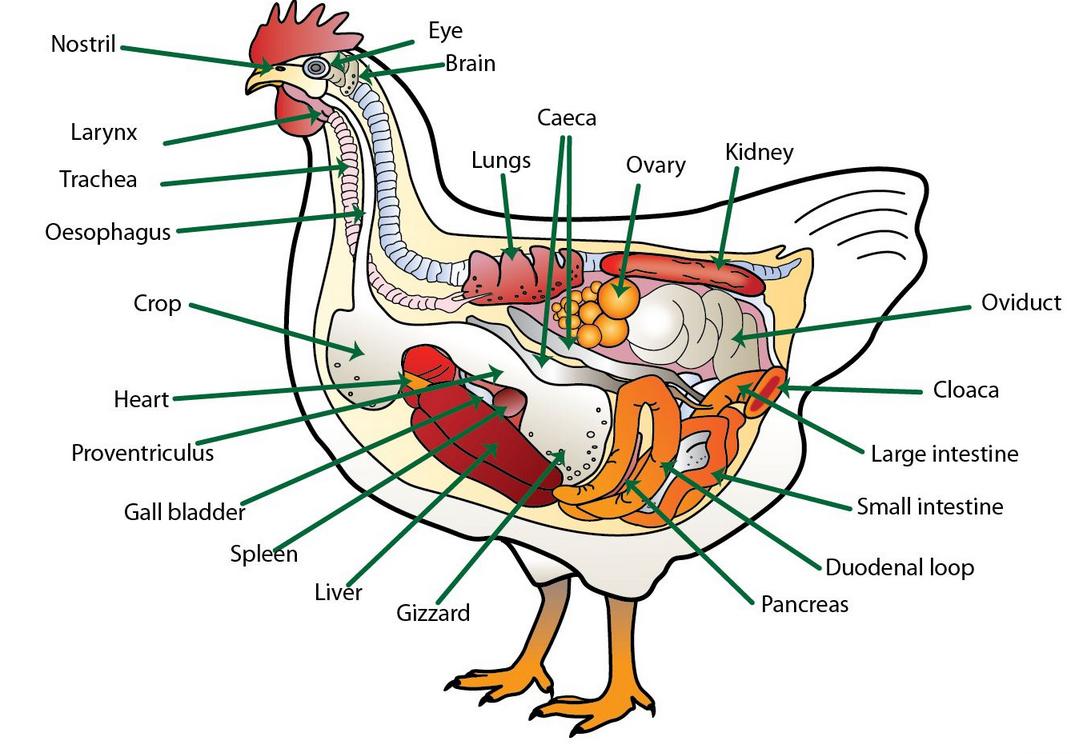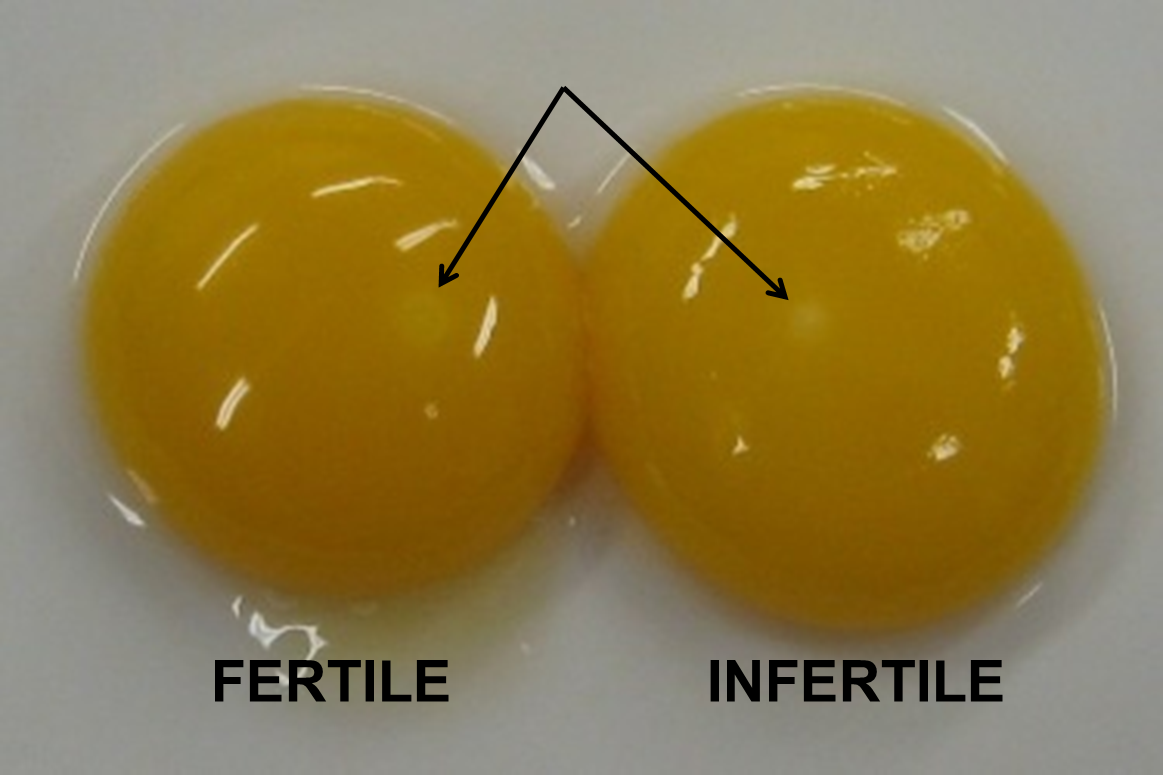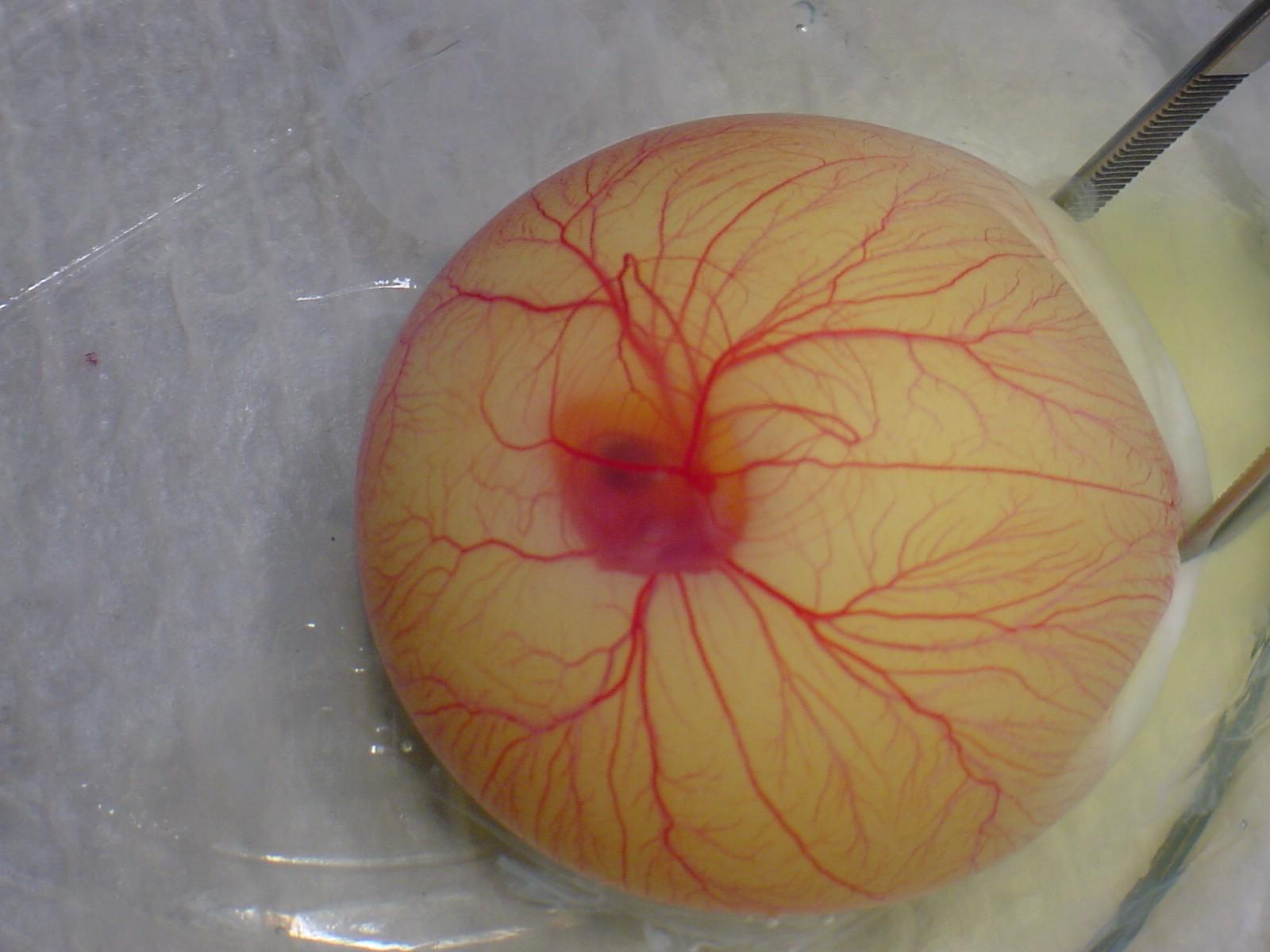Poultry Biology
Poultry Biology
Anatomy
Knowledge of the anatomy and physiology of an animal is essential for understanding and correcting, any problems that may arise. For example, knowledge of the digestive system assists in understanding the nutritive requirements of chickens. In addition, knowing what is ‘normal’ can also help you recognize and take action when the digestive system goes awry. Similarly, knowledge of the female reproductive system is important for understanding any problems that may arise regarding egg production, fertility, and hatchability.
Chickens are omnivores, meaning they eat both plants and animals. In the wild chickens often scratch in the soil to search for seeds and insects. They also eat larger animals such as lizards and young mice.
Unlike cows, chickens do not have a rumen so are not able to digest the cellulose of forage. This is important when pasturing chickens.
ASC-203: Avian Digestive System
Feed passage in broilers - A complex problem (University of Florida)
Poultry eggs are part of a unique reproductive system. The egg serves to protect and provide nutrients to the developing embryo. Since the embryo receives no additional nutrients from the hen, the egg must contain all the nutrients essential for life.
Chickens mate when the male mounts the female and they have a 'cloacal kiss' in which the cloaca of both chickens touch for a few seconds. This is sufficient time for the sperm to transfer from the male to the female.
ASC-201: Avian Female Reproductive System
Unlike mammals which have their male reproductive organs outside of the body, all the reproductive organs of a male bird are located inside the body cavity. The body temperature for birds, at 106-107F, is higher than that of mammals. This means that avian sperm have to be able to withstand higher temperatures than their mammalian counterparts.
ASC-199: Avian Male Reproductive System
Birds don’t breathe the same way mammals do. Like mammals, birds have two symmetrical lungs that are connected to a trachea (windpipe). But here the similarity ends.
ASC-200: Avian Respiratory System
All animals have a skeleton to allow them to stand up and protect their internal organs and tissues. The avian skeletal system looks similar to its mammalian counterparts, but there are some important differences. Many of these differences relate to the bird’s need to be light enough to fly while still maintaining the needed body support.
ASC-202: Avian Skeletal System
All animals have three of types muscles: smooth, cardiac, and skeletal. Smooth muscle is controlled by the autonomic nervous system (ANS) and is found in the blood vessels, gizzard, intestines, and organs. The cardiac muscle is the specialized muscle of the heart. Skeletal muscle is the type of muscle responsible for the shape of the chicken and for its voluntary movement. The poultry meat you eat is skeletal muscle.
ASC-204: Avian Muscular System

Embryology
Birds have a unique reproductive system. For mammals the offspring develop in the uterus of the mother. In birds, however, the offspring develop in an egg the mother laid. The egg provides protection and nutrients to the developing embryo. The egg must contain all the nutrients essential to the development of the embryo it carries. As a result, the egg is a convenient, self-contained package for studying embryology.


- ASC-195: Development of the Chick
- Incubating and Hatching your Own Eggs
- Embryology: The study of life (PennState) - Provides teachers with background information and experiential activities dealing with the life sciences for use in the classroom. Each activity is designed to be grade-level appropriate and has been correlated to the U.S. National Science Education Standards
- University of Illinois - Incubation and Embryology
- Chickscope 1.5 - University of Illinois
- Penn State - Embryology in the classroom
4-H National Curriculum
- Hatching: Classroom Projects - Helper's Guide Beginner (4H CCS BU 07595) This activity book is for 4-H members ages 7-11. 4-H'ers will learn life skills, and science skills as well as skills in embryology such as incubation, preparing a brooder, handling chicks, and exploring careers in the poultry industry
- Experiments in Poultry Science - Helper's Guide Advanced (4H CCS BU 07596) This activity book is for 4-H members ages 12-14. 4-H'ers will learn life skills, and science skills as well as skills in embryology such as hatching, identifying parts of an egg, collecting data about embryos and chicks, and many others
Feedstuffs
- The ABCs of Farming coloring book - is a coloring book Feedstuffs created to honor the many U.S. farm families that dedicate their lives each day to the production of our food and proper care of our farm animals. Drawn by Feedstuffs FoodLink artist Jessi Brummer and authored by Sarah Muirhead, the pictures and messages within provide a glimpse into what food production is all about and the strong values of U.S. farm families in providing the daily essentials of life. Taking young readers through The ABCs of Farming is sixth-generation farmer Trent Loos.
American Egg Board
- Eggs 101: A video project - Comprehensive, award-winning egg production education program to educate young consumers about the good animal care practices of the egg industry; the teacher's PDF on this disc provides reviews and exercises to correspond with each chapter.
- Egg Reader (Grades 3-5) - The Egg Reader is an 8-page, full-color brochure for grades 3-5. Topics covered include food safety, specialty eggs, animal well-being, egg components, and grading.
- Shelly and Shelldon's Eggscellent Adventure (K-4) - Includes wood games, crafts, puzzles, experiments, and recipes.
Arkansas Egg Council
- The following publications are available from the Arkansas Egg Council, located at P.O. Box 8505, Little Rock, AR 72205.
- Eggory's Egg-Craft Ideas (Pre-K-6): This 14-page booklet helps children learn about eggs through art and cooking projects. It includes a wide range of activities. One copy is available to Arkansas residents at no charge.
- Egg-ceptional Ideas for Food Science Creations (9-12): This 15-minute video shows consumer uses for eggs and details nutritional information and the unique characteristics of eggs that make them so useful. It is valuable for beginning science classes.
Livestock Conservancy
- Noah's Ark Today online curriculum: The program is centered on the fundamental concept that the farmyard is a great place to explore, teach, and learn. The program was designed for grades K-5 with a focus on science and social studies.
US Poultry and Egg Institute
- Hova-Bator Model 1588 Incubator for use in the classroom (Richard Dunne)
- Video of an ostrich laying an egg
- Video of an emu laying an egg
- Watch an ostrich egg hatch
- Watch an emu egg hatching in the wild
- Incubating rhea eggs
The University of Alberta (Canada)
- The hatching egg industry - Part 1
- The hatching egg industry - Part 2
- Incubation and the hatchery - Part 1
- Incubation and the hatchery - Part 2
- The table egg industry - Part 1
- The table egg industry - Part 2
- The egg grading facility
- The turkey industry - Part 1
- The turkey industry - Part 2
- The broiler industry
Genetics
An understanding of general genetic principles is important when breeding for flock improvement. The University of Utah's Genetic Science Learning Center has an excellent website exploring the principles of genetics.
Every individual has two sets of chromosomes - one from the mother and one from the father. Each set contains a sex chromosome which is important in determining the gender of the animal. It is important to note, however, that genetic sex determination in birds (including poultry species) is very different from that of mammals (such as us), as shown below.
Genetics of sex determination in mammals versus birds:
|
MAMMALS (e.g., humans, cows, etc.) Male = XY Female = XX Males determine the sex of the offspring |
BIRDS (including all poultry species) Male = ZZ Female = ZW Females determine the sex of the offspring |
In mammals there are two possible sex-chromosomes - X and Y. Females have two X chromosomes (XX) while males have one of each (XY). Male mammals, therefore, determine the gender of the offspring. In birds, however, the two sex chromosomes are Z and W. The females are ZW and the males are ZZ. For birds, therefore, it is the female that determines the sex of the offspring.
Poultry genetics for pastured production (ATTRA)
The genetics for feather pattern, eggshell color, body confirmation, and other traits are controlled by different genes on different chromosomes of the chicken. A summary of the different genes on particular chromosomes can be found at the Coop.org website. There is also a chicken color calculator online.
Behavior
Normal behavior (eXtension)
Behavioral problems (eXtension):
Behavior management (eXtension)
